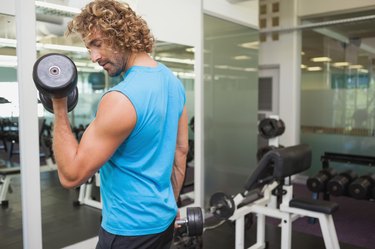
Properly done, a biceps curl should isolate the biceps muscle, using only that muscle to lift the weight. However, some common mistakes can lead to strain in other muscles, causing pain. Upper-back pain during a biceps curl indicates that there is an issue with your form or that an underlying injury is acting up.
Posture Is Key
Video of the Day
One of the most common mistakes people make when performing biceps curls is allowing their shoulders to roll forward. This slouch places strain on the muscles of your upper back because they are being stretched by the rounding of your back at the same time as they are working to support the weight you're holding in your hands. To correct this problem, focus on your posture. Stand up straight, look directly ahead and imagine your shoulder blades gliding down your back. Your shoulders shouldn't move at all during the biceps curl. The only movement should happen at your elbow joint.
Video of the Day
Stabilize the Shoulder Girdle
If you find it difficult to maintain correct posture while performing biceps curls, you are probably lacking in strength in your upper back, especially in the muscles surrounding your shoulder joint. To strengthen these muscles, try an exercise called the cobra. Begin lying face-down on the floor with your arms straight by your sides. Imagine pulling your shoulder blades together and rotating your shoulders open. Extend your upper back just a bit, allowing your head, collarbone and arms to lift away from the floor. Hold for one second and then lower down. Repeat 12 times. The movement should be small and focused on the drawing together of the shoulder blades. Do not arch your lower back; it should remain neutral.
Drop Some Weight
If improving your posture and strengthening the muscles of your upper back doesn't help, you may need to decrease the amount of weight you're trying to curl. If you overload your biceps by lifting more weight than you're ready for, the muscles of your chest and upper back will get involved, tensing up and potentially causing pain. You should never lift so much weight that it compromises your form in this way. The body adapts quickly to weight training, so if you practice your curls consistently, you will build enough strength to lift more weight over time.
When to See a Doctor
If your pain persists even with modifications to the exercise, it is time to see a doctor. Continuing to lift weights when you are in pain could result in serious injury. If you consistently feel pain during biceps curls, you may already have an injury that has yet to be diagnosed. In this case, the best option is to rest or consult with a doctor or physical therapist for a more detailed analysis of the causes of your pain.